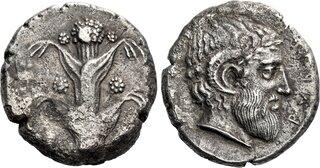| Numismatica Ars Classica > Auction 146 | Auction date: 8 May 2024 |
| Lot number: 2296 Price realized: This lot is for sale in an upcoming auction - Bid on this lot  | Show similar lots on CoinArchives Find similar lots in upcoming auctions on |
| Lot description: Cyrenaica, Barce. Tetradrachm 380, AR 25 mm, 12.84 g. Silphium plant with leaves and flowers. Rev. BAPKAI retrograde Laureate head of Zeus Ammon r. BMC 23 (these dies). Traité III 1962. Very rare. Surface somewhat porous, otherwise good very fine Ex Leu 77, 2000, 399 and NAC 84, 2015, 742 sales. About three or four generations after Cyrene was founded, a new settlement, Barce, was established in the 570s or 560s B.C. It was located about seventy-five miles westwards down the coast from Cyrene, and sixteen miles inland, in the midst of a large and fertile plain. The impetus for the new colony was a feud among the brothers of Cyrene's ruling Battiad family, then led by Arcesilaus II. Rarely does a family quarrel have such great consequences: Barce became one of the most prosperous Greek cities of North Africa, such that it rivalled the capital. Like Cyrene, it submitted to Persian rule late in the 6th Century B.C., yet the people of Barce still seem to have enjoyed a good degree of autonomy before a general revolt was staged. The Persian governor of Egypt, Aryandes, responded with great force, destroying the city, and taking most of its people into captivity. Barce recovered with relative speed, no doubt because of its resources. If the designs of coinage can be taken as evidence, it would seem that the main product of Barce at this time was the silphium plant. A veritable cure-all, it is said to have had hundreds of medicinal and cosmetic uses, in addition to being a source of food. It was indigenous to Cyrenaica and apparently resisted all attempts at mass cultivation. The value of silphium as a source of food for cattle and the popularity of its juice in regional and foreign markets contributed to its extinction by the 1st Century A.D. It often is shown in great detail on coinage, and Robinson, in his 1927 work that served as the final volume of 'A Catalogue of the Greek Coins' in the British Museum, was able to identify the three major variants of its depiction. Estimate: 6000 CHF |  |



